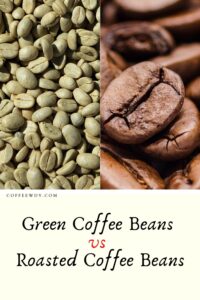Green Coffee Beans vs Roasted Coffee Beans
 Wondering the differences between green coffee beans vs roasted coffee beans?
Wondering the differences between green coffee beans vs roasted coffee beans?
Just Enjoying a Cup….
If you’re like me, you’ve probably been drinking coffee for a long time without thinking too much about what goes into producing it. As long as the cup of joe tastes good and isn’t decaf, I’m usually satisfied with my morning brew, but there’s so much more to a cup of coffee than the grounds you’re loading into your machine every morning. When I started working with coffee shops and roasters four years ago, I thought green coffee beans were something I might get as a side dish when I ordered steak at a restaurant, but in the coffee world, they are the vital beginnings of every drink you could enjoy.
What are Green Coffee Beans?
Before your coffee grounds were in a bag waiting to be brewed, they were roasted coffee beans. And before that, they were “green beans”. Green beans are, simply, dried coffee beans that have yet to make their way through a roaster. After harvesting, coffee is stored in its “green” form, because it can be stored for long stretches of time without loss to the quality of its taste.
Green beans are distinguishable from roasted beans in almost every sense. They range in color from pale grey to the deep green for which they are named. Their texture is spongy, and they smell and taste more like green tea or grass clippings than the coffee you’re used to.
While you can’t make drinkable coffee using green beans, they’ve recently been linked to several potential health benefits. Because green beans contain a large amount of chlorogenic acids, which are known antioxidants, some believe that taking a supplement of green bean extract can help lower blood pressure, and Dr. Oz famously claimed green beans could aid in weight loss.
Why Roast Coffee Beans?
Roasting is the process that transforms green coffee beans into the coffee beans that you can use to make a cup of coffee or a shot of espresso. Roasting dries out the beans, and in the process it removes most of the chlorogenic acids that are present in green beans. The beans are spun through a roaster and brought up to tremendous heat, only to be quickly cooled once they’ve reached a peak temperature.
The chemical reaction taking place within the heated beans is what gives coffee its distinct scent and flavor. Minuscule difference in temperature or roasting length can produce dramatic differences in the final product, which makes coffee roasting as much of an art as it is a science. You might be familiar with the broad terms “Light Roast” and “Dark Roast”, but the possibilities for roasting are endless.
In short: Green Coffee Beans vs Roasted Coffee Beans
After coffee plants have been grown, they need to be harvested and the beans roasted before they can be sent out to shops, cafes, and restaurants for use. What’s harvested directly from the plants are “green coffee beans” that can be stored for long periods of time without any loss of quality. Those green coffee beans are heated and spun in roasters, darkening their color, drying their texture, and deepening their aroma until they become coffee beans that are viable for making coffee. There’s an endless variety of coffee roasts in the world, but all of them start out as green beans.
